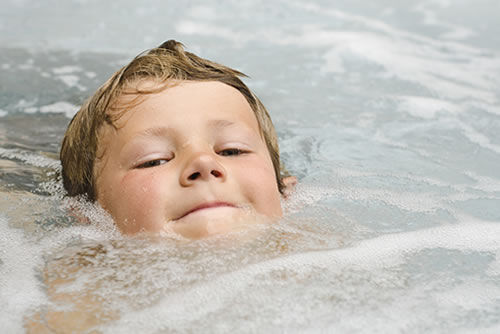Are you thinking about getting a shuffleboard table for your game room? Excellent work. Let’s talk about a vital component of your setup before you start envisioning elaborate tournaments with your friends: the size of your shuffleboard table.
The issue is that professional shuffleboards are an amazing 22 feet long and 20 inches wide. Let’s face it, most of us don’t have a mansion-sized game room lying around. Understanding these dimensions (as well as the alternatives) is crucial to choosing the perfect table that will actually fit your space and give you years of entertainment.

For those with limited space, shorter tables are perfect. They range in length from 9 to 14 feet and are a lot of fun, even though they won’t give you the full tournament experience. Whether you want a table for weekend entertainment or you use your basement as a gathering spot, picking the right size can make the difference between a table that is used every day and one that ends up collecting dust.
Understanding Shuffleboard Table Dimensions
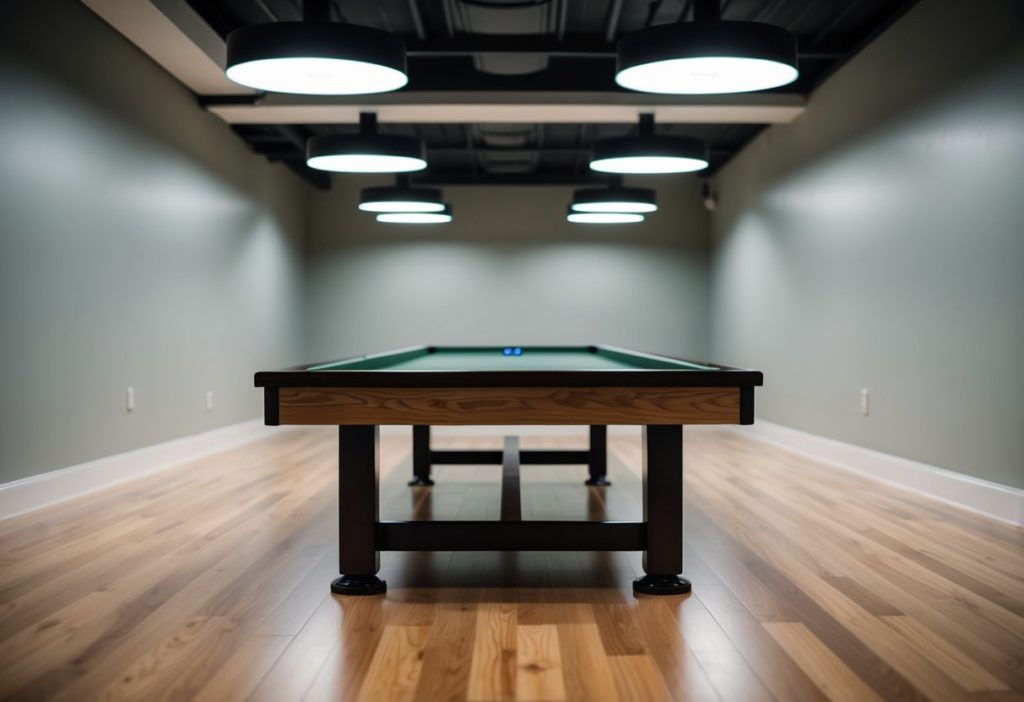
A shuffleboard table‘s dimensions are more than just a list of figures on a specification sheet; they are the foundation of your entire gaming experience. You will either be pressed for space or the gameplay will be unimpressive if you do it wrong.
The Standard Regulation’s Size
A regulation shuffleboard table’s exact measurements are twenty feet long by twenty inches wide. Your pucks should glide smoothly across the table on the actual playing surface, which should be 16 to 20 inches wide. The thickness, which usually ranges from 2 to 3 inches, is primarily determined by stability and durability.
To be honest, a lot of our customers are excited about regulation size. It is regarded as the gold standard. These dimensions are followed by most commercial venues and competitive players. However, what is not mentioned in the sales brochures is that this requires a very large room.
Smaller options, such as 9, 12, and 14-foot tables, are very popular for use at home even though they don’t technically fit official regulations. This won’t matter much to you and your visitors, though, unless you plan to host professional competitions in your recreation area.
Requirements for the Play Space
Reality kicks in at this point. You can’t just measure the table and be done; you need some breathing room.
Each end of the table should have a minimum of two feet of space. Trust me. It’s not pleasant to watch people trying to make shots while pressed up against a wall, and we’ve set up tables in confined areas before. Your aim suffers, your posture deteriorates, and, to be honest, it’s no longer enjoyable.
A room that is at least 12 feet wide and 28 feet long is required for a full 22-foot table. It’s larger than the living rooms of most people! It’s just practical, which is why so many homeowners choose shorter tables.
Some people choose to use tables with adjustable sizes in areas with limited space. Despite their flaws, they can be a good middle ground. That clearance space, however, is a must for comfortable play and should never be compromised.
Types of Shuffleboard Tables
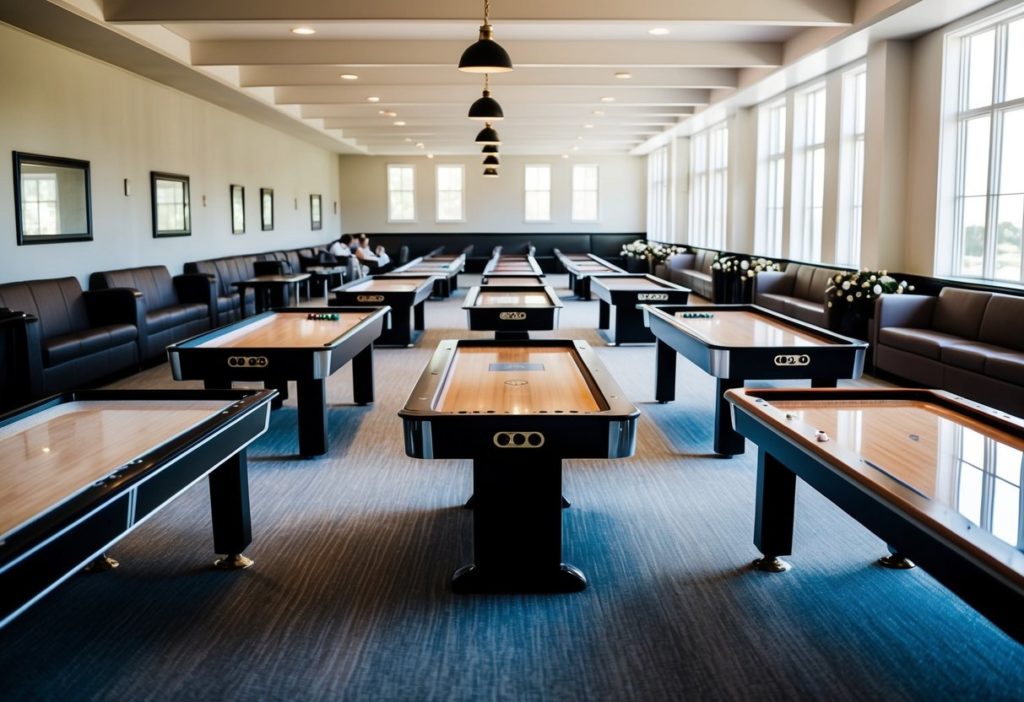
Not every shuffleboard table is made equally. Your space, financial constraints, and level of game seriousness will all influence the type you select.
Models of Full-Size Competition
The most common sizes of full-size competition tables are 16, 18, and 20 feet, though they can be anywhere between 16 and 22 feet long. Serious game rooms and commercial establishments use these tables.
Competition tables usually have high-quality wood, like maple, for the playing surface. This is due to the fact that maple provides the smooth, stable surface that serious players need. The length of the game makes it more challenging to master, requiring extraordinary control and skill.
The width stays consistent at around 20 inches, giving players plenty of space to make accurate shots. The drawback is that these tables can be rather costly. You’re investing in high-quality parts, skilled workmanship, and that authentic playing experience.
Canadian Home Leisure carries Colt Shuffleboard tables, which are among the best options available for competition quality. These are not rash purchases; rather, they are investments in years of entertainment.

Mid-Sized and Smaller Tables
Mid-sized tables, which are usually 12 to 14 feet long, are ideal for a lot of homeowners. Although they take up less space than full-sized tables, they still offer a good playing experience. The 12- and 14-foot models are particularly popular in this category.
Then there are the compact 9-foot models, which are perfect for apartments and game rooms that are smaller. Although they don’t offer the same level of difficulty as larger tables, they are excellent for novice players and families.
Often made of less costly materials, these smaller tables have more affordable price points. You and your loved ones will still have a terrific time even if your maple surface isn’t suitable for a tournament.
Construction and Material Considerations
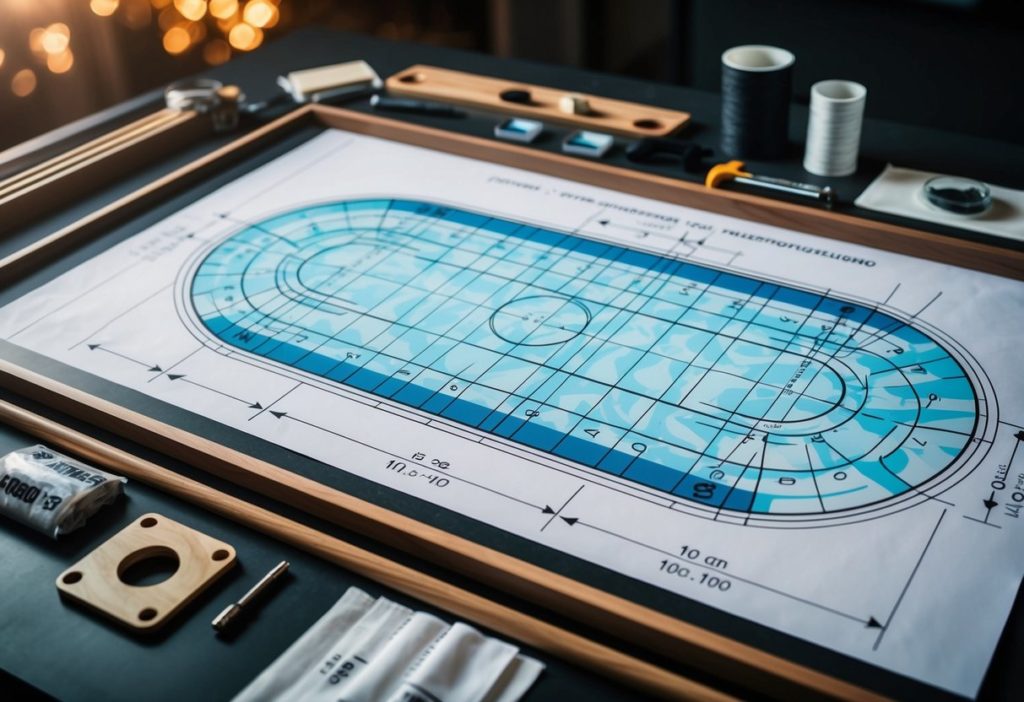
The details are important when building a shuffleboard. These factors will determine whether your table lasts five years or fifty.
The Quality of the Playing Surface
The playing surface has a big impact on your shuffleboard experience. Most high-quality tables are constructed from solid wood, with maple being the most popular choice due to its hardness and smooth finish. Although some manufacturers use other types, maple is still the most widely used hardwood.
A polyurethane coating protects the wood and ensures the smooth, rapid play you want. Consistency is essential because any dips or bumps in the finish will drive you crazy while you’re playing. The standard playing surface length varies widely, ranging from the regulation 22-footers to the tiny 9-foot home models.
We’ve tested dozens of surfaces over the years, and you can immediately tell the difference between a high-quality and a low-quality maple surface. Your pucks should glide smoothly, not cling to objects or deviate from the course.
Base and Frame Durability
The frame and base of your table are its actual foundation. Metal and solid wood are frequently used materials, but the choice affects weight and durability. You want a table that doesn’t move when you’re playing intense games.
Metal frames add a great deal of durability, but they can make the table heavier to move. If you choose to use wood, hardwoods like oak or maple are your best bet. A well-made table will remain level and stable even during heated matches.
The corners of the base construction have been cut, causing too many tables to wobble or shift when being played on. Don’t act that way.
Height and Comfort
Most adults can play shuffleboard standing because most of them are between 30 and 32 inches tall. Decades of gameplay have tested and refined this, so it’s not arbitrary.
But height isn’t the only factor in comfort. Because of its design, you should be able to lean slightly on the table without feeling any pain or strain on your back. Some manufacturers offer height-adjustable options for families with varying heights or accessibility needs.
Additional Features and Accessories
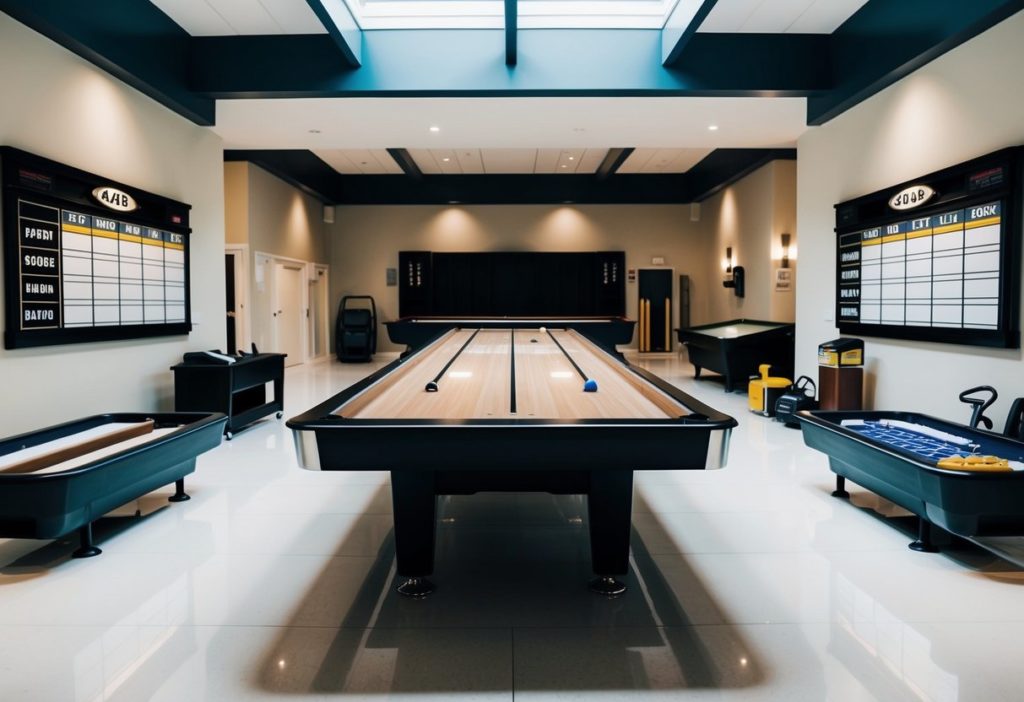
With a few extras, a basic shuffleboard table can become the center of attention in your game room. These features enhance gameplay while extending the life of your investment.
Score Systems and Gutters
Scoring systems range from basic manual abacuses to complex electronic displays with LEDs. The majority of visitors appreciate the modern touch that those electronic scoreboards provide, but most home players can get by with manual systems.
Gutters catch stray pucks to keep your playing area clear. High-quality gutters also reduce noise, which your upstairs family or neighbors will surely appreciate. Most players find that the factory options are sufficient, though some improve their gutters or create creative do-it-yourself scoring systems.
Maintenance and Lighting
It’s not glamorous, but it’s very important to maintain it properly. Regular waxing reduces friction and maintains your pucks’ smooth motion. Cleaning supplies and table coverings offer dust and scratch protection and are relatively cheap purchases with substantial returns.
Lighting has a big impact on gameplay. Many tables have built-in LED lights, but some have lamps that can be attached. By minimizing eye strain and emphasizing the scoring area, good lighting enhances the enjoyment and competitiveness of games.
The lighting setup can make the difference between squinting to see where your puck landed and confidently planning your next shot.
Installing a Shuffleboard at Home
Until you try to find a spot that works just right, it may seem obvious that most shuffleboards are placed along straight walls. Unlike pool tables, shuffleboards hug the walls rather than the middle of a room, but finding the perfect flush fit can be challenging.
Full-size shuffleboards present serious logistical challenges. These planks of wood are huge, harsh, and very heavy. Getting them down stairs or through confined spaces? You don’t want to face that nightmare alone. It’s well worth hiring professionals to move and arrange your table because each piece is heavy.
Many smaller shuffleboard tables are single-piece, which simplifies setup but limits your options if you need to move later. Tables over 12 feet typically disassemble for easier mobility if you plan to move in the coming years.
Some units include scoreboard cabinets, which add bulk and take up extra space. In homes where every square foot matters, electronic scoring can reduce the overall setup footprint.
Frequently Asked Questions
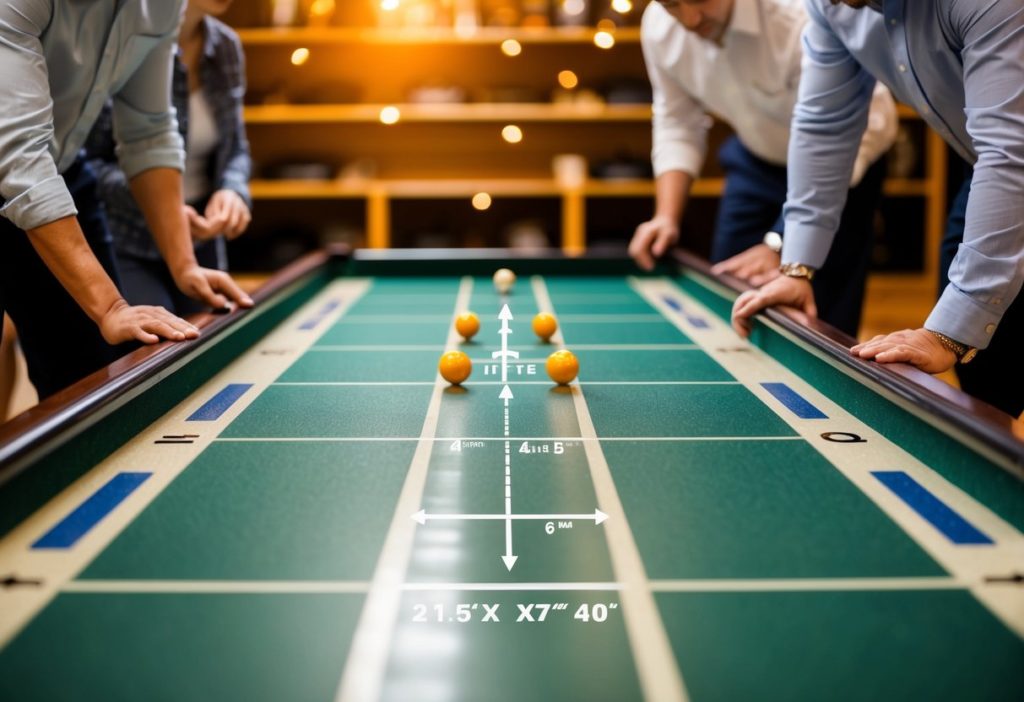
Let’s talk about the most common questions we get from customers who want to buy shuffleboard tables.
What are the standard dimensions of a shuffleboard table?
Standard regulation tables are 22 feet long and 20 inches wide, though home versions usually measure between 9 and 14 feet.
How much room is needed around a shuffleboard table?
Having at least two feet of space on all sides is essential, especially where players are shooting. Anything less detracts from the playing experience.
Are there different sizes for indoor and outdoor use?
There are comparable size options even though outdoor tables are usually more resilient and weatherproof. Indoor tables vary more because of space constraints.
For a game to be enjoyable, how long must it be?
We recommend a minimum distance of 12 feet for a really enjoyable game. Anything less makes shuffleboard feel cramped and limits the strategic elements that make it fun.
What distinguishes shuffleboard tables at bars from those at home?
Bar tables are typically longer and designed to withstand heavy commercial use. The size of home tables can be changed to accommodate different room sizes.
Does a table’s width change with its length?
Regardless of length, width usually stays around 20 inches, though some small house models may have slightly different proportions to better fit specific spaces.
Shuffleboards come in a range of sizes, with models as short as nine feet and as narrow as sixteen inches, according to Shuffleboard Shopping’s Reality Billiards stores. Most retailers won’t tell you this right away. Larger tables are obviously more costly, but construction and material quality also play a big role.
The gameplay is pretty much the same on tables 16 feet and up. Tables wider than 18 inches provide ample room for comfortable play. If you go smaller than that, you’ll definitely notice the difference in gameplay quality.
If you’re considering purchasing a small shuffleboard, think about making your puck smaller as well. With a diameter of 2¼ to 2⅝ inches, standard pucks are too big for tables that are less than 18 inches wide.
Remember that the length of the table is not the only space consideration. Players need to have at least two feet of space behind each end in order to shoot comfortably. If you compromise on this, your posture (and game) will suffer.
The span of the shuffleboard affects more than just gameplay; it affects how people move through your entire room and how your room is laid out. A player needs adequate clearance to maintain proper shooting posture; any less makes the game feel cramped and uncomfortable, which takes away from the fun.



